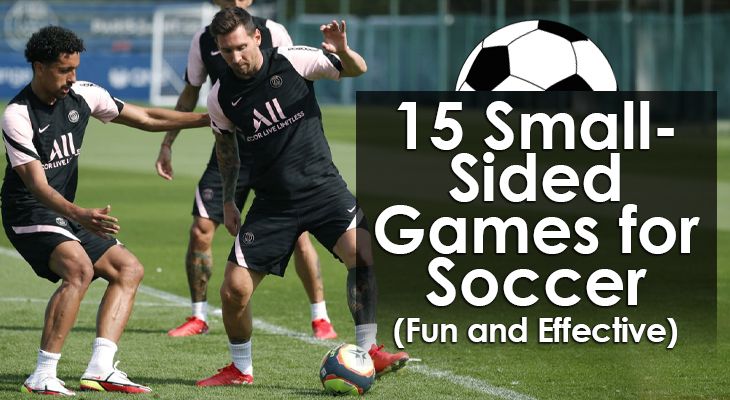17 Small-Sided Games for Soccer (2024 Update)
An effective way of getting the best results for your team is by replicating game situations during training sessions.
To achieve this, a coach needs to come up with soccer drills that involve multiple players at once playing against each other.
Coaches should give specific instructions designed to target the growth of a particular skill or improve decision-making.
Small-sided games have proven to be a very efficient way of going about this.
The games listed below will allow you to keep each drill small enough that you can focus on each player with more attention.
They also allow for the concurrent running of various sessions with different purposes for different players.
Benefits of Small-Sided Soccer Games
Some of the key benefits of small-sided games in soccer training include:
- More touches on the ball for each player
- Opportunity to give players a rest by rotating during sessions
- More attacking and defensive phases of play
- More engaging and fun activity (which is particularly beneficial for young players)
- Better replication of real game situations
- More space to run into, and more goal-mouth action
- More freedom to express creativity
- More opportunities for 1v1 duels in attack and defense
- Better opportunity for boosting fitness and stamina
- Quicker transitions between defense and attack
- More opportunities to work on and improve technical ability
- Better placed system for monitoring player progress and providing individual feedback
SSG's are mostly recommended for soccer players that belong to the younger age groups.
However, they're still useful for senior teams with the right adaptation of the types of games used.
In this article, I'll share some fun and effective small-sided games that you can add to your training regime.
We'll cover 10 key aspects and skills in soccer, including:
- Warm-ups
- Passing
- Dribbling
- 1v1s
- Crossing
- Shooting
- Goalkeeping
- Defending
- Attacking
- First Touch
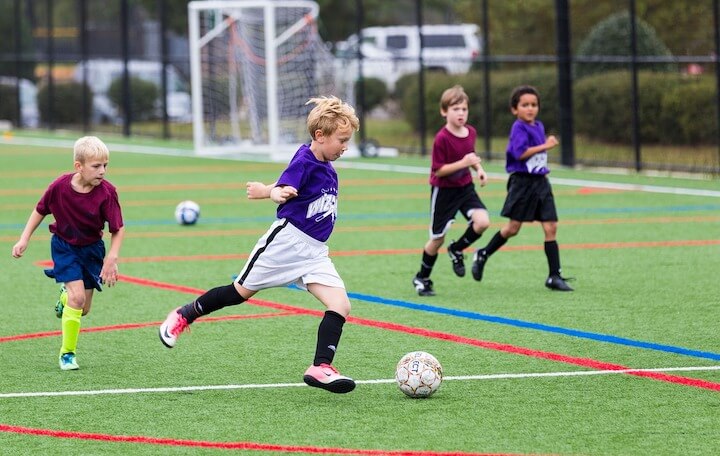
Small-Sided Games For Warm-Ups
1. A Game of Four Fields
Setup:
• Four teams of four (or more) players each
• 4 sets of differently colored bibs for each team
• Two goalkeepers
• A playing area 50 yards long with the width of a penalty area
• 4 soccer balls
Directions:
(1) Each team passes the ball between each other until a goalkeeper calls a team’s color.
(2) The player currently in possession of the ball in that team immediately takes a shot on goal.
(3) The keeper retrieves the ball and throws it back to the team
2. Tag
Setup:
• A square area of play
• 2 players in bibs
Directions:
(1) The 2 players in bibs run around the square trying to tag the other players.
(2) Once tagged, that player must freeze and wait for a teammate to tap and unfreeze them.
(3) After playing like this a couple of times, introduce a ball.
(4) Now, players must try to avoid getting tagged while dribbling a ball around the square.
(5) If a player gets tagged, they have to wait for a teammate to pass a ball between their legs to “unfreeze” them.
Small-Sided Games For Passing
3. Passing in Circles
Setup:
• A circular area of play
• 2 teams of 4 players each (one player in the circle for each team)
Directions:
(1) Two opposing players inside the circle compete for possession when the ball is played into the field.
(2) The winner passes the ball out to a teammate outside the circle who then joins the field for a 2v1.
(3) The game progresses in this manner until one team has all its players inside the field.
(4) When that happens, that team must complete 6 consecutive passes to win the game.
4. Man-Marked
Setup:
• 2 teams of 6 players each
• A square playing area
Directions:
(1) Each player picks an opponent to pair up with.
(2) Players can only tackle the person they picked.
(3) Each player tries to keep possession within their team by passing the ball to a teammate while under pressure from their paired opponent.
(4) Each time a team wins possession, they get a point.
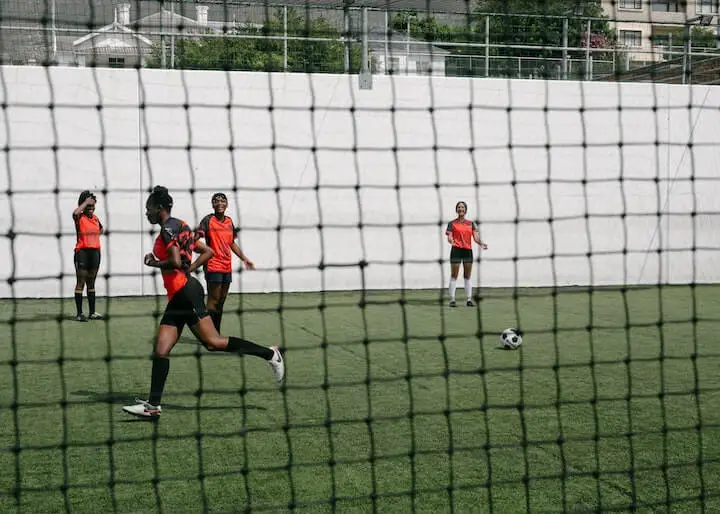
Small-Sided Game For First Touch
5. Touch, Touch, Shoot
Setup:
• A small, square playing area
• 2 teams of 3 players each
• One goalpost
Directions:
(1) The attacking team has three attacking players while the defending team has two defensive players and one goalkeeper.
(2) Each attack must involve all three attacking players take a shot.
(3) Each player must complete two touches on each pass - one to receive the ball and stop it, and the other to open up the body and pass to another teammate.
(4) If one of the defenders wins possession, the teams switch roles and repeat the process.
Small-Sided Games For Dribbling
6. Safe House
Setup:
• 2 teams of 4 players each
• A rectangular playing area
• Four soccer balls
Directions:
(1) One team starts the game from outside the rectangle, lined up beside each other.
(2) Each person should be facing an opponent standing directly in front of them within the rectangle.
(3) The team outside the field is the attacking team.
(4) Each attacker must dribble to the other end of the rectangle - the safe zone - without losing possession to the opponent.
(5) If all four attackers make it to the other side, then the teams switch roles and go again.
(6) If any attacker loses possession, he/she becomes a defender for the next round, leading to an overload against the new attacking team.
7. What The Coach Says
Setup:
• A square playing area
• 2 teams of 4 players each
Directions:
(1) Play a normal 4v4 game, but this time you’re giving orders on how the players should dribble.
(2) When a team is in possession, call out an action such as “Switch feet”, “Change direction”, “Inside foot”, etc. to tell the player what to do.
(3) If the player does not successfully complete the order before releasing / losing possession, their team gets a point deduction.
(4) If the player completes the order, their team gets a point.
Small-Sided Game For 1v1 Duels
8. Always On The Move
Setup:
• 2 teams of 4 players each
• A square field
• Two Cones
• 4 Flags
• One Large goalpost
• Two mini goalposts
• Multiple soccer balls
Directions:
(1) On one side of the square, place the large goalpost.
(2) Place the 4 flags, two cones, and two mini goalposts to serve as extra goals on the remaining three sides of the square.
(3) Each side of the square should have one defender and one attacker.
(4) Place multiple soccer balls in the middle of the area.
(5) Each attacker must always be on the move, picking up balls from the middle and trying to score past the defenders.
(6) Each time an attacker scores, their next attempt must be on another side of the square.
Small-Sided Games For Crossing
9. Cross, Cross, Cross
Setup:
• 2 teams of 8 players each (including the goalkeepers)
• A field with two full-size goalposts
Directions:
(1) Each team should have two wide players. The goal is to get the ball out to these wide players as soon as the game starts.
(2) Each time gets the wide player gets the ball, they must take a maximum of two touches before sending a cross into the opponent‘s area for teammates to try and score.
10. The Overlapping Game
Setup:
• Teams of 5 players each (including the goalkeepers)
• A field with two full-size goalposts
Directions:
(1) Each team should have one goalkeeper, defender, fullback, winger, and striker.
(2) The striker begins the game by entering from outside the field, passing the ball to the fullback, and making a run into the opponent’s area.
(3) The fullback receives the ball, passes to the winger, and immediately bursts forward for an overlapping run.
(4) The winger cuts inside with the ball and then cuts the ball back to the overlapping fullback.
(5) The fullback tries to take a first-time cross to the striker now in the opponent’s area.
(6) The opponent’s defender tries to put the striker off from taking a shot.
(7) Repeat the process for the other team.
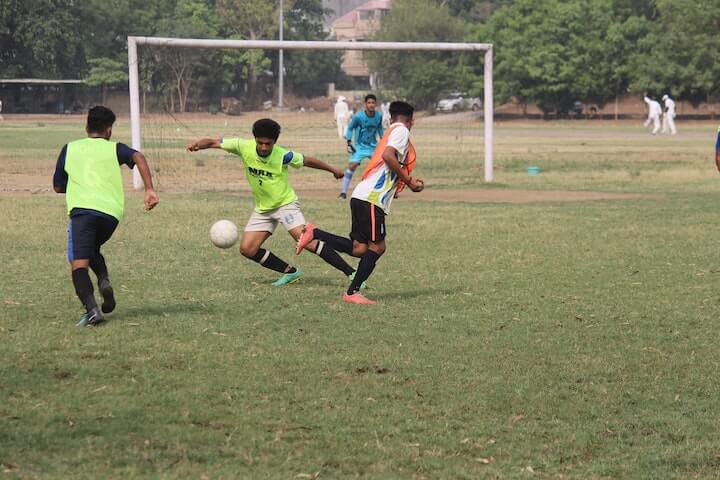
Small-Sided Games For Shooting
11. Long Rangers
Setup:
• 2 teams of 4 players each
• One goalkeeper
• One ball
Directions:
(1) Both teams take turns being the attackers and defenders.
(2) The attacking team should have three players outside the penalty area, and one player inside the penalty area.
(3) The defending team should have three players inside the penalty area and one player outside.
(4) The attacking team pass the ball among each other and must take a shot on goal from outside the area within six passes.
(5) The attacker inside the area floats around, waiting for a chance to pounce on a rebound or deflection.
(6) The defenders inside the area try to block shots and clear the ball.
(7) The defender outside the area puts pressure on the attackers.
(8) After a specific number of goal attempts, both teams switch roles and repeat the process.
12. Keep Away
Setup:
• One team of 6 defenders
• One team of 3 attackers (players rotate depending on the number of players
• One ball
• Two goalposts
Directions:
(1) The coach begins the game by throwing the ball into the field for the players to go after.
(2) If an attacker gains possession, their team can immediately try to score in any of the goalposts while the 6 defenders try to win the ball and stop the goal.
(3) If a defender gains possession, their team passes the ball among each other to retain possession.
(4) Team get awarded a goal for every completed sequence of 10 passes.
(5) Rotate the attackers as often as possible to allow other players to participate.
Small-Sided Game For Goalkeeping
13. Strikers and Goalies
Setup:
• A rectangular field
• Two goalkeepers
• Two goalposts
• Multiple soccer balls
• 2 teams of three attackers each
• Two mannequins
Directions:
(1) Place the mannequins side by side in the middle of the field.
(2) The attackers line up outside the field, alongside each goalpost.
(3) One attacker enters the field from both ends at a time, and the goalkeepers roll the ball forward for them.
(4) Each attacker runs forward with the ball and takes a shot on goal immediately they get past the mannequins.
(5) The goalkeeper tries to save the shot and throw the ball back out for the next player in two quick moves.
(6) For a punch, the goalkeeper gets one point. For holding the shot, they get two points.
(7) After each attempt, the attacker leaves the field to give the next teammate on the line a turn.
(8) The first goalkeeper to score 15 points wins the round.
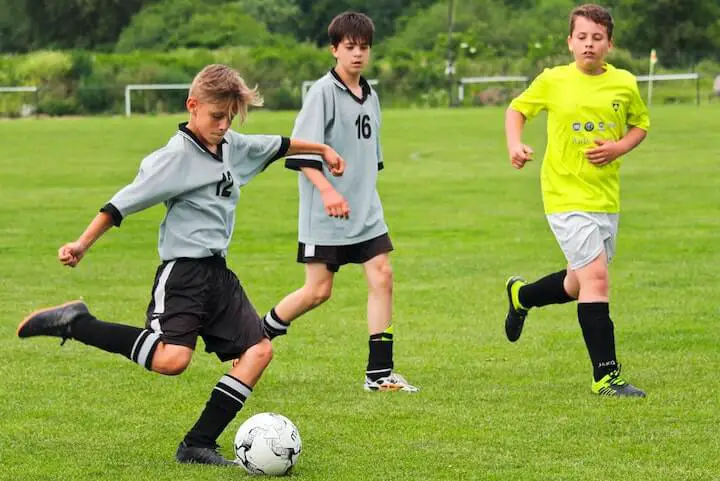
Small-Sided Game For Defending Phases of Play
14. Rondo Switch
Setup:
• Two rectangular playing areas
• 2 teams of 5 players each
• One ball
Directions:
(1) In one area, there should be five attackers and two defenders.
(2) In the second area, the remaining three players from the defending team.
(3) Play a game of rondo in the first area.
(4) If the defending team wins possession, they have to try and quickly transition play into the second area where they have teammates.
(5) If successful, they become the attackers, and the previous attacking team has to send two players over to their area to try and win the ball back.
Further Reading: Check out 9 more Rondo variations
Small-Sided Game For Attacking Phases of Play
15. Eyes Forward
Setup:
• Two goalposts
• 2 teams of 5 players each including goalkeepers
Directions:
(1) Play a normal 4v4 game, but with a variation where the player in possession is not allowed to turn with the ball until a goal is scored.
(2) They may do sideways passes, but the player must not physically turn.
Small-Sided Games For All-Round Play
16. Four-Goal - 3v3
Setup:
30 x 20-yard mini-field with two mini-goals on each end
Teams of 3 players each compete at a time (no goalkeepers)
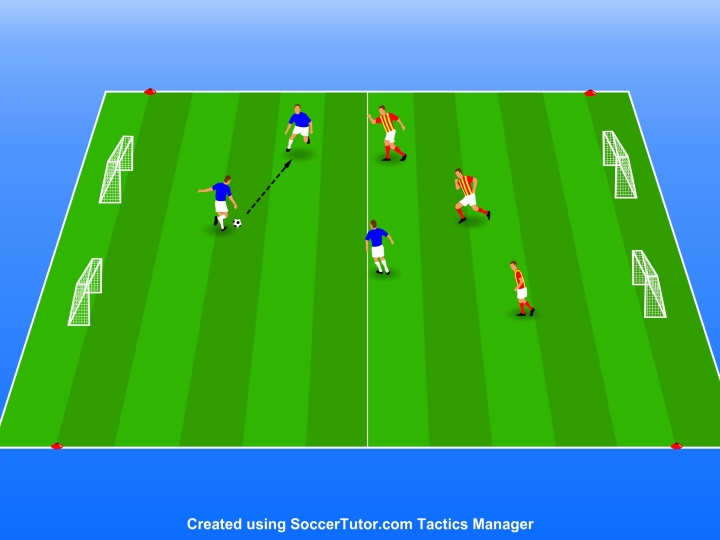
Directions:
(1) Teams play in a regular 3 v 3 game but either team can score into two different goals.
(2) In possession, each player has a maximum of two touches before they have to pass (three touches total).
(3) Defenders may not tackle. Instead, they must intercept or block to gain possession.
(4) The ruleset forces players to focus mainly on quick passing, movement, and positioning.
(5) Since the goals are small, encourage players to get as close to the goal as possible before taking a shot.
(6) The first team to score three goals wins
(7) Run a winner-stays-on format.
17. Wide Play - 3v3
Setup:
30 x 20-yard mini-field.
Create channels on each wing of the field, five yards wide, spanning the full length of the field.
One full-size goal on each end line.
Team divides into groups of four.
Each group elects one player to play on the wing (right side). That player must only play inside the wide channel.
No other players are allowed inside the wide channels.
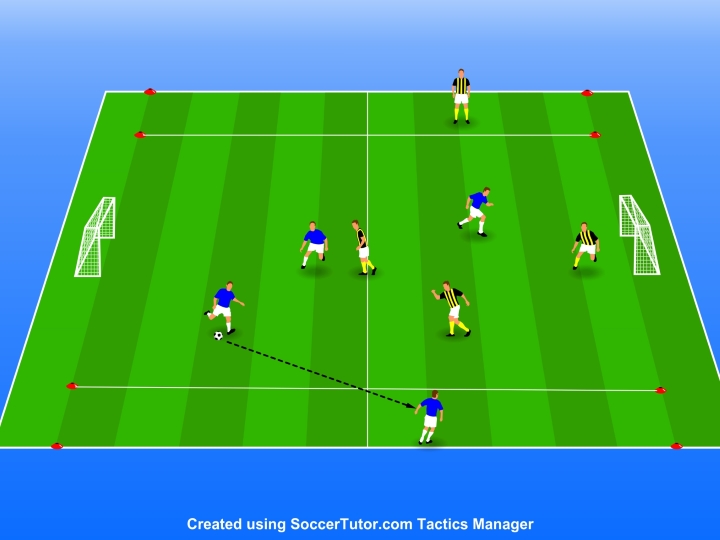
Directions:
(1) The coach starts the game by kicking the ball into the center of the field.
(2) Teams compete in a regular 4 v 4 game with a twist: to score, the ball must pass through the wide area at least once.
(3) The wingers for each team may not score.
(4) The first team to score three goals wins.
(5) Introduce new teams after each round.
(6) After all teams have played, repeat the drill but place the wingers on the opposite side.
Conclusion
As mentioned earlier, these small-sided games give players more 'individual' coaching time.
They also turn regular boring training sessions into fun and interesting ones.
This is why these small-sided games are so effective for developing young players.
These games place players in game-like situations, and their problem-solving skills are properly tested in various aspects of the game.
After all, a key purpose of soccer training is preparation for the unpredictable nature of the game.
If you’re a coach looking for a way to spice up your training sessions, or a player looking to take more responsibility for your development at your local training ground, then the games discussed here are as good a place to start as any.
Best of luck!

